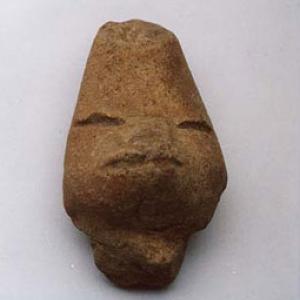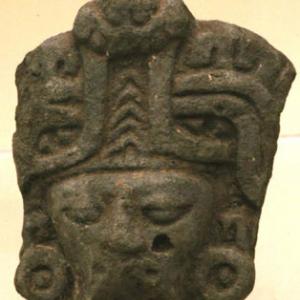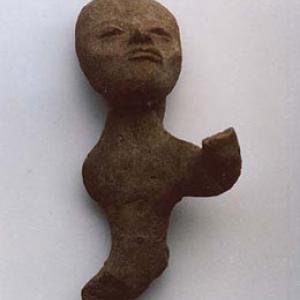Civilisation of Teotihuacán (100-750 A.D.)
Teotihuacán was an important centre located a few dozen kilometres northeast of modern-day Mexico City. Although it was abandoned by its founders due to the arrival of other populations, the city remained an important religious centre for long time, until the fall of the Aztec empire. People considered Teotihuacán (which means ‘the place where gods were created’) the burial place for those ancient deities who had sacrificed themselves to allow the rebirth of the world after its end.
The two residential areas of Tepantitlán and Tetitla (whose fresco painted houses were the residences of priests) and the ceremonial centre are what remains of the city. In the ceremonial centre it is possible to admire the Temple of Quetzalcoatl, the Pyramid of the Sun (the highest pre-Columbian pyramid, 65 m. high) and the Pyramid of the Moon, which is connected to the Citadel (an architectonic complex with a large square plaza) through the Avenue of the Dead (the axis of the city, 2 km. long and 45 m. wide).
The pyramids are decorated with bas-reliefs and the most common materials used for construction are stone, adobe (sun-dried mud brick) and stucco.
Teotihuacán sculptors made extensive use of a decorative technique known as ‘incrustation’, especially used to fill the ocular cavities of the carved figures with shells, obsidian and gemstones.
The flourishing period of the city coincided with the production of gemstone masks (jadeite, serpentine rock, basalt, alabaster), realized with the above mentioned technique of incrustation and probably placed on the faces of the dead during the funeral ceremonies.
As for ceramics, the most typical shape is the cylindrical three-legged vase with conical top and decorated with cloisonné technique: potters polished the dark coloured terracotta and painted the decorative carved or scraped figures with a cinnabar paint which gave them a brilliant red colour.
Another typical production was that of votive figurines: heads or entire figures with mobile limbs which were realized with a mould.
Candelero, I - VII sec. A.D, Mexico

Candelero, I - VII sec. A.D, Mexico

Candelero, I - VII sec. A.D, Mexico

Candelero, I - VII sec. A.D, Mexico

Anthropomorphic head, 7th century A.D. (Teotihuacán IV), Mexico

Anthropomorphic head, 7th century A.D. (Teotihuacán IV), Mexico

Anthropomorphic head, 7th century A.D. (Teotihuacán IV), Mexico

Anthropomorphic head, 7th century A.D. (Teotihuacán IV), Mexico

Anthropomorphic head (part of a whole figurine), III - IV century A.D. (Teotihuacán II), Mexico

Anthropomorphic head (part of a whole figurine), III - IV century A.D. (Teotihuacán II), Mexico

Anthropomorphic head (part of a whole figurine), III - IV century A.D. (Teotihuacán II), Mexico

Anthropomorphic head (part of a whole figurine), III - IV century A.D. (Teotihuacán II), Mexico

Anthropomorphic head (part of a whole figurine), V - VI century A.D. (Teotihuacán III), Mexico

Anthropomorphic head (part of a whole figurine), V - VI century A.D. (Teotihuacán III), Mexico

Anthropomorphic head (part of a whole figurine), V - VI century A.D. (Teotihuacán III), Mexico

Anthropomorphic head (part of a whole figurine), V - VI century A.D. (Teotihuacán III), Mexico

Anthropomorphic head, III - IV century A.D. (Teotihuacán II), Mexico

Anthropomorphic head, III - IV century A.D. (Teotihuacán II), Mexico

Anthropomorphic head, III - IV century A.D. (Teotihuacán II), Mexico

Anthropomorphic head, III - IV century A.D. (Teotihuacán II), Mexico

Small head / anthropomorphic

Small head / anthropomorphic

Small head / anthropomorphic

Small head / anthropomorphic

Anthropomorphic head, II - VII century A.D. (Teotihuacán II - III), Mexico

Anthropomorphic head, II - VII century A.D. (Teotihuacán II - III), Mexico

Anthropomorphic head, II - VII century A.D. (Teotihuacán II - III), Mexico

Anthropomorphic head, II - VII century A.D. (Teotihuacán II - III), Mexico

Anthropomorphic head, 7th century A.D. (Teotihuacán IV), Mexico

Anthropomorphic head, 7th century A.D. (Teotihuacán IV), Mexico

Anthropomorphic head, 7th century A.D. (Teotihuacán IV), Mexico

Anthropomorphic head, 7th century A.D. (Teotihuacán IV), Mexico

Anthropomorphic head, III - IV century A.D. (Teotihuacán II), Mexico

Anthropomorphic head, III - IV century A.D. (Teotihuacán II), Mexico

Anthropomorphic head, III - IV century A.D. (Teotihuacán II), Mexico

Anthropomorphic head, III - IV century A.D. (Teotihuacán II), Mexico

Candelero, V - VI century A.D. (Teotihuacán III), Mexico

Candelero, V - VI century A.D. (Teotihuacán III), Mexico

Candelero, V - VI century A.D. (Teotihuacán III), Mexico

Candelero, V - VI century A.D. (Teotihuacán III), Mexico

Funerary mask

Funerary mask

Funerary mask

Funerary mask

Anthropomorphic votive figurine (mutila), V-VI sec. A.D (Teotihuacán III), Mexico

Anthropomorphic votive figurine (mutila), V-VI sec. A.D (Teotihuacán III), Mexico

Anthropomorphic votive figurine (mutila), V-VI sec. A.D (Teotihuacán III), Mexico

Anthropomorphic votive figurine (mutila), V-VI sec. A.D (Teotihuacán III), Mexico





